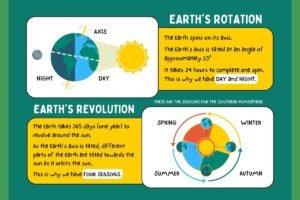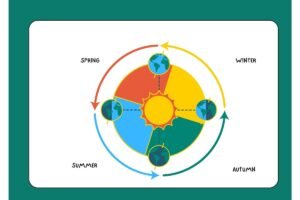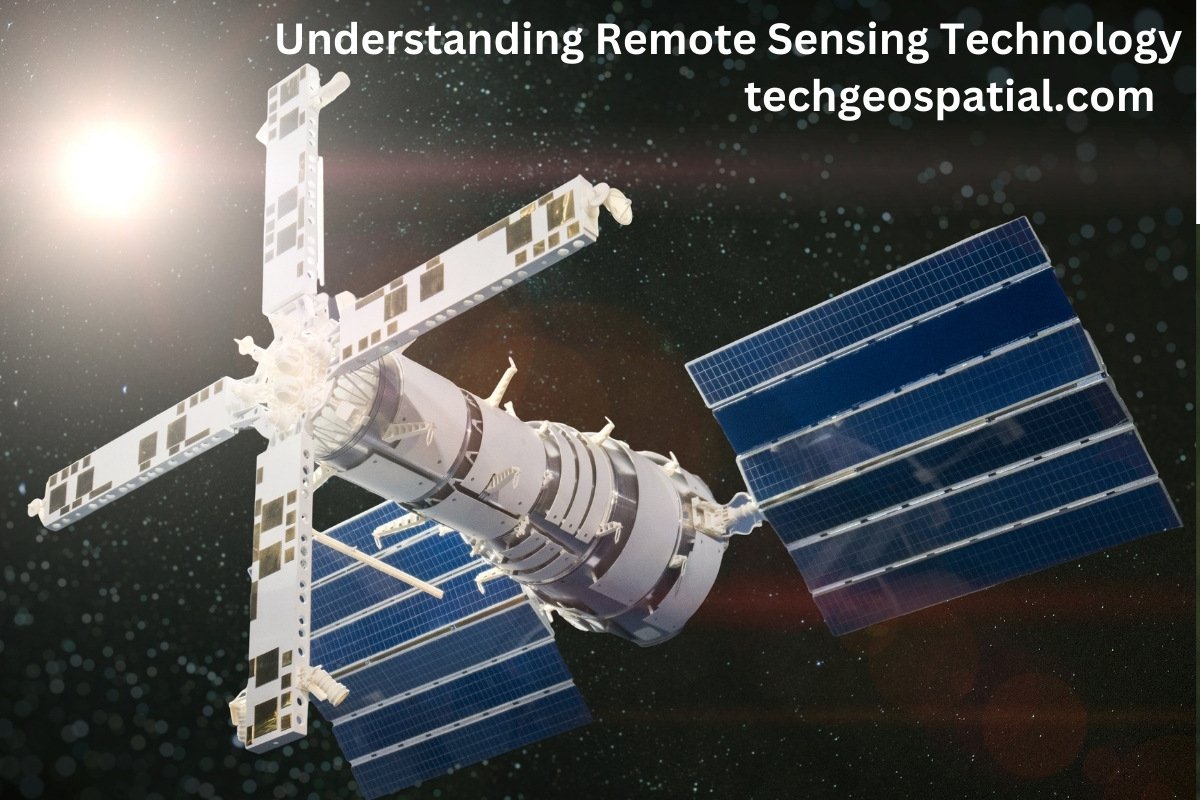The rotation of the Earth
The rotation of the Earth is one of its fundamental motions, causing the planet to spin on its axis from west to east. This rotational movement has several important effects on Earth’s behavior, climate, and environment.

Here are some of the key effects of the Earth’s rotation:
- Day and Night Cycle: Earth’s rotation is responsible for the alternating cycle of day and night. As the Earth rotates, different parts of the planet are exposed to sunlight, creating daytime in the regions facing the Sun and nighttime in the regions facing away from it. The rotation of the Earth results in approximately 24 hours for a complete cycle of day and night.
- Coriolis Effect: The Earth’s rotation causes the Coriolis effect, which is the apparent deflection of moving objects, such as winds and ocean currents, due to the rotation of the Earth. In the Northern Hemisphere, moving objects are deflected to the right, while in the Southern Hemisphere, they are deflected to the left. The Coriolis effect influences global wind patterns, ocean currents, and weather systems.
- Formation of Trade Winds and Westerlies: The Coriolis effect, combined with the differential heating of Earth’s surface, results in the formation of global wind patterns known as trade winds and westerlies. Trade winds blow from east to west in the tropics, while westerlies blow from west to east in the mid-latitudes. These wind patterns play a crucial role in shaping climate and weather systems around the world.
- Ocean Circulation: The rotation of the Earth also influences ocean circulation patterns. Similar to the Coriolis effect on winds, ocean currents are deflected by the Earth’s rotation, leading to the formation of major ocean currents such as the Gulf Stream in the North Atlantic and the Antarctic Circumpolar Current in the Southern Ocean. These currents transport heat, nutrients, and marine life across the oceans, influencing climate and ecosystems.
- Centrifugal Force: Earth’s rotation generates a centrifugal force that causes a slight bulge around the equator, resulting in the Earth’s shape being slightly flattened at the poles and bulging at the equator. This bulge contributes to the oblate spheroid shape of the Earth and affects measurements of gravity and geodetic surveys.
- Daylight Hours and Seasons: The tilt of Earth’s axis combined with its rotation around the Sun leads to variations in daylight hours and the changing seasons. As the Earth orbits the Sun, different hemispheres receive varying amounts of sunlight, resulting in the seasonal changes experienced throughout the year.
Overall, the rotation of the Earth is a fundamental aspect of its dynamics, influencing everything from the length of day and night to global climate patterns and ocean circulation. Understanding these effects is essential for studying Earth’s climate, weather, and environmental systems.
The revolution of the Earth
The revolution of the Earth refers to its orbit around the Sun in an elliptical path. This motion has significant effects on various aspects of Earth’s behavior, climate, and environment.
Let’s explore some of the key effects of Earth’s revolution:
- Seasonal Variations: One of the most notable effects of Earth’s revolution is the changing seasons. As the Earth orbits the Sun, its axis remains tilted at an angle of approximately 23.5 degrees relative to its orbital plane. This tilt, combined with the Earth’s revolution, leads to variations in the angle and intensity of sunlight received by different parts of the planet throughout the year. This results in the four distinct seasons: spring, summer, autumn, and winter.
- Sunlight Distribution: Earth’s revolution influences the distribution of sunlight across its surface. During the course of a year, different latitudes receive varying amounts of sunlight due to the tilt of the Earth’s axis and its orbit around the Sun. This variation in solar radiation affects temperature patterns, weather phenomena, and ecosystem dynamics around the globe.
- Length of Daylight Hours: Earth’s revolution also affects the length of daylight hours experienced at different times of the year. As the Earth orbits the Sun, the angle at which sunlight strikes the planet’s surface changes, leading to longer days and shorter nights in the hemisphere tilted towards the Sun (summer) and shorter days and longer nights in the hemisphere tilted away from the Sun (winter).
- Solar Energy Input: The varying distance between the Earth and the Sun during its elliptical orbit affects the amount of solar energy received by the planet. Earth is closest to the Sun (perihelion) in early January and farthest from the Sun (aphelion) in early July. While this difference in distance has a relatively small effect on global climate, it does contribute to the overall distribution of solar energy and influences seasonal temperature variations.
- Climate Patterns: Earth’s revolution plays a crucial role in driving large-scale climate patterns and atmospheric circulation systems. The seasonal changes in solar radiation distribution lead to shifts in temperature gradients, pressure systems, and wind patterns, which in turn influence weather phenomena such as monsoons, hurricanes, and seasonal precipitation patterns.
- Ecosystem Dynamics: The changing seasons resulting from Earth’s revolution have profound effects on ecosystems and biodiversity. Seasonal variations in temperature, precipitation, and daylight hours influence plant growth, animal behavior, migration patterns, and reproductive cycles, shaping the structure and functioning of terrestrial and aquatic ecosystems.
Overall, the revolution of the Earth around the Sun is a fundamental aspect of its behavior and environment, influencing everything from seasonal changes to global climate patterns and ecosystem dynamics. Understanding these effects is essential for studying Earth’s climate system, predicting weather phenomena, and managing natural resources in a changing environment.
The concepts of solstice and equinox
The concepts of solstice and equinox are fundamental astronomical events that mark key points in Earth’s orbit around the Sun. Let’s explore each concept:

- Solstice:
-
- Solstice refers to the two points in the Earth’s orbit around the Sun when the Sun reaches its highest or lowest point in the sky as observed from Earth. There are two solstices each year: the summer solstice and the winter solstice.
- Summer Solstice: The summer solstice occurs around June 21st in the Northern Hemisphere and around December 21st in the Southern Hemisphere. During the summer solstice, the Sun reaches its highest point in the sky, resulting in the longest day and shortest night of the year in the Northern Hemisphere, and the shortest day and longest night of the year in the Southern Hemisphere.
- Winter Solstice: The winter solstice occurs around December 21st in the Northern Hemisphere and around June 21st in the Southern Hemisphere. During the winter solstice, the Sun reaches its lowest point in the sky, resulting in the shortest day and longest night of the year in the Northern Hemisphere, and the longest day and shortest night of the year in the Southern Hemisphere.
- Equinox:
-
- Equinox refers to the two points in the Earth’s orbit around the Sun when the Sun is directly above the equator, resulting in equal lengths of day and night across the globe. There are two equinoxes each year: the vernal equinox and the autumnal equinox.
- Vernal Equinox: The vernal equinox, also known as the spring equinox, occurs around March 21st in the Northern Hemisphere and around September 21st in the Southern Hemisphere. During the vernal equinox, day and night are approximately equal in duration, marking the beginning of spring in the Northern Hemisphere and autumn in the Southern Hemisphere.
- Autumnal Equinox: The autumnal equinox occurs around September 21st in the Northern Hemisphere and around March 21st in the Southern Hemisphere. Similar to the vernal equinox, day and night are approximately equal in duration during the autumnal equinox, marking the beginning of autumn in the Northern Hemisphere and spring in the Southern Hemisphere.
These astronomical events have been observed and celebrated by cultures around the world for thousands of years, marking important milestones in the changing seasons and the cycle of life. They have also played significant roles in the development of calendars, agricultural practices, and cultural traditions.






good